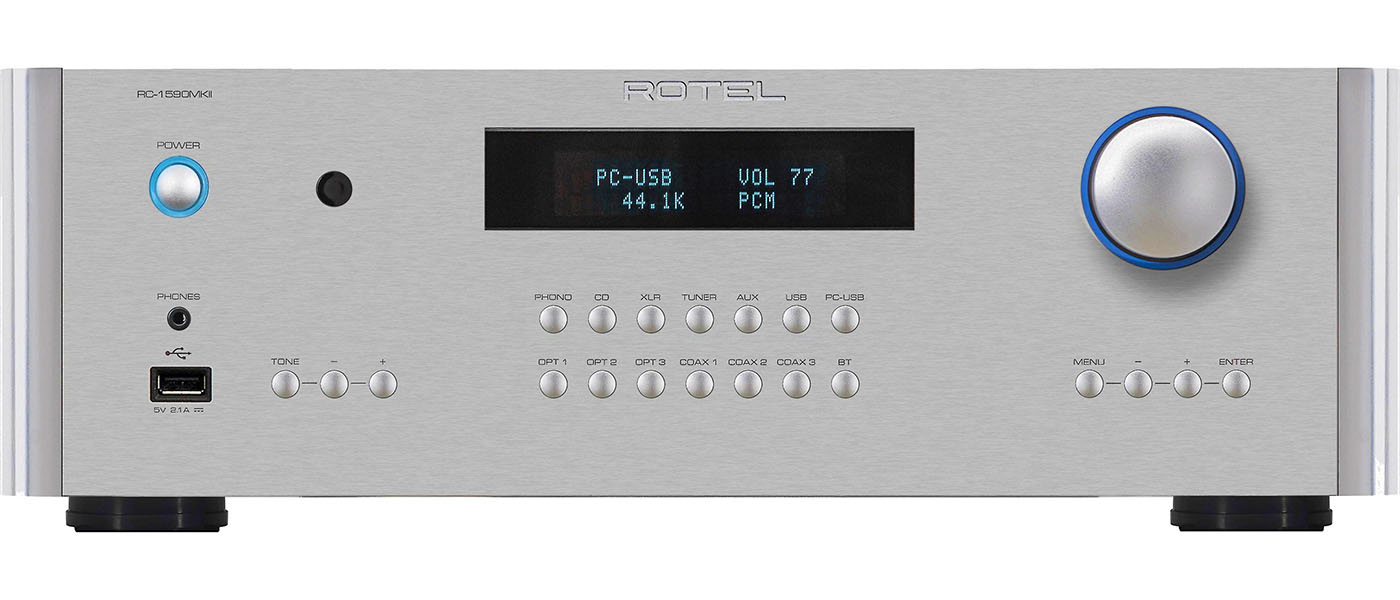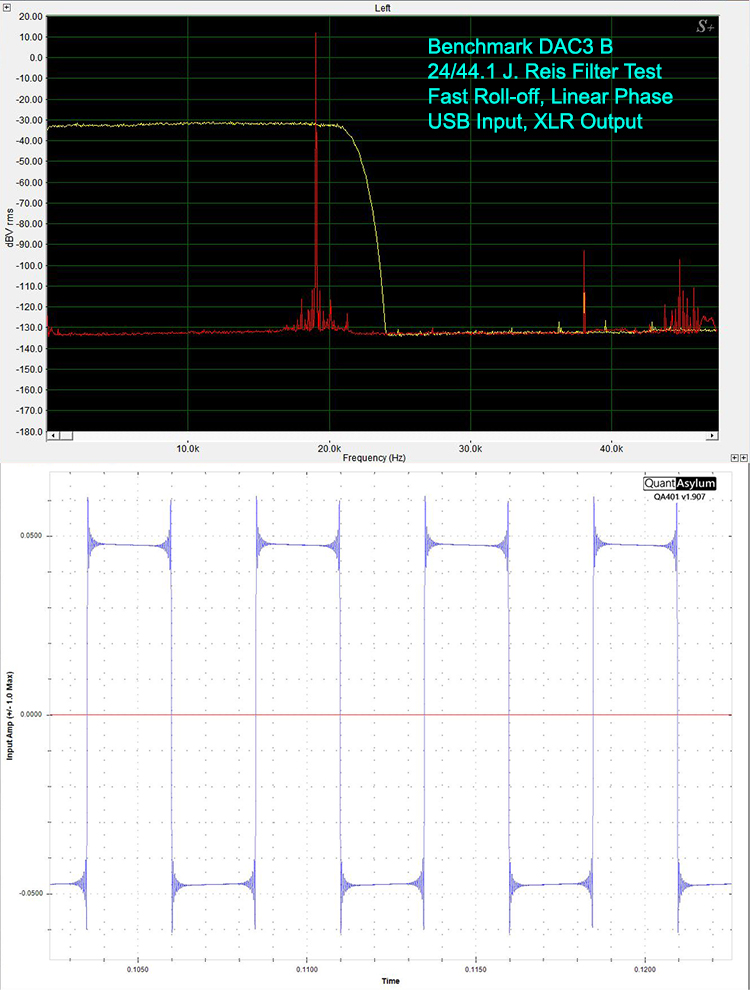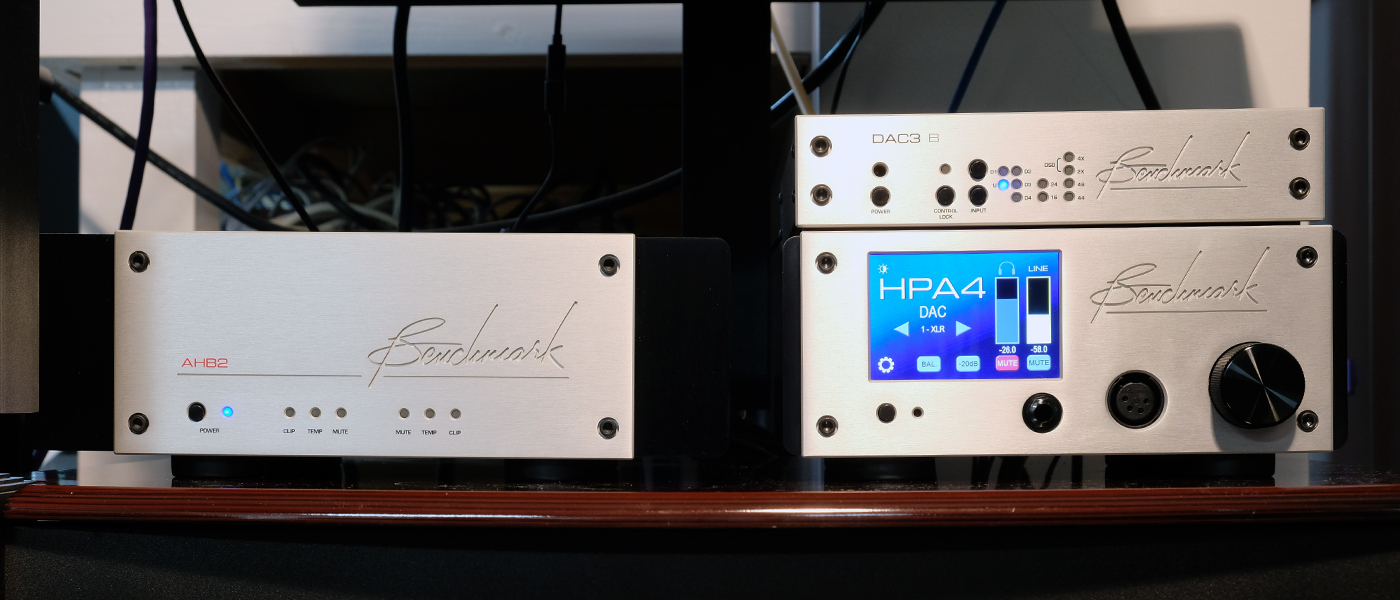
Audiophiles love to mix n’ match components. Both as a means to find the best performing/sounding gear for a given purpose and to express an owner’s individuality. But is there an advantage or synergy to having a stack of equipment, designed to work together, by the same manufacturer? Benchmark Media Systems provides us with a test case. A stack of 3 highly engineered components that have been well received and regarded on their own, but when used together the company claims they extract the most transparent musical performance possible.
Benchmark Media HPA4 Preamplifier-AHB2 Power Amplifier-DAC3 B DAC
- Advanced engineering and novel technology in each component.
- Some of the lowest measured distortion audio products available.
- Components have a small and tidy footprint.
- Together they compose the cleanest sounding music chain that I have ever heard.

Regardless of what we may hope, nothing is perfect. Nothing. And while it can be fun to chase after some pinnacle of a goal or state of being, it also can turn into a very daunting task. As audiophiles or even just music lovers in general, we all have our own sense of what we consider as that “perfect sound” in each of our systems. Some of us look for the absolute best-measured performance, while others look to hear that auditory “certain something special” that triggers the requisite endorphin rush. Benchmark Media Systems is a well-regarded brand that is known for its high-quality DACs and ADCs that also find their way into professional studios. In 2014 they introduced the AHB2 power amplifier, using patented THX AAA amplifier technology, that brought previously unheard of low levels of distortion, and high SNR capability. Last year Benchmark released the LA4 preamplifier and the HPA4 headphone amplifier. Both components use an ultra-precision relay-based volume control and feature vanishingly low levels of distortion. The HPA4 is essentially identical to the LA4 but with the added headphone drive capabilities via a THX-888 amplifier section. The DAC 3B is an alternate version of the DAC3 DX that Editor-In-Chief John E. Johnson Jr., Ph.D. reviewed previously. The 3B simply does away with the included volume control and headphone jacks which makes it ideal to use with the HPA4 or LA4. I have sampled these components individually at audio shows and have always come away impressed by both their sound quality and ease of use. This review was originally going to be focused on the HPA4, and it mostly still is, but the opportunity arose to use a complete Benchmark “stack” if you will, for an extended length of time to get a measure of how these impressive individual components work together as one cohesive unit.
HPA4 Preamplifier
Design:
2-channel Stereo Preamplifier/Headphone Amplifier
Amplifier Section:
THX-888 based AAA (Achromatic Audio Amplifier)
Volume Control:
256-step relay based with 0.5 dB increments
Frequency Response:
– 0.003 dB at 10 Hz, -0.001 dB at 20 kHz (manufacturer)
Output Impedance:
(Headphone) almost 0 Ohms, (XLR Line Out) 60 Ohms
THD (20Hz – 20 kHz):
(Headphone) < -125 dB (0.00006%), (XLR Line Out) < -125 dB (0.00006%)
SNR (A-Weighted):
(Headphone) > 135 dB, (XLR Line Out) > 137 dB
Maximum Output Power:
(Headphone) 6 Watts into 16 Ohms
Maximum Output Current:
(Headphone) 1.5 A
Maximum Output Voltage:
(Headphone) 11.5 Vrms into 300 Ohms
Maximum Input and Output Voltage:
(XLR Line in and out) 20 Vrms (+28 dBu)
Inputs:
2 pair Analog XLR, 2 pair Analog RCA
Outputs:
1 pair Analog XLR plus single summed mono XLR, 1 pair Analog RCA (Line out)
Single 1/4-inch phono. Single 4-pin balanced (Headphone out)
Finish:
Silver or Black
Dimensions (W x H x D):
8.65″ W x 3.88″ H x 8.33″ D – Including Feet
Weight:
8.0 lbs.
Warranty:
1 year, extendable to 5 years (USA/Canada) or 2 years (International) with product registration
MSRP:
$ 2,999.00
AHB2 Power Amplifier
Design:
2-channel Stereo Power Amplifier
Type:
Class AB with Class H rails. THX AAA (Achromatic Audio Amplifier)
Frequency Response:
Better than 0.1 Hz – 200 kHz, +0/-3 dB (manufacturer)
Continuous Average Power Output (manufacturer):
(At < 0.0003 % THD+N at full rated power, 20 Hz to 20 kHz) 100 Watts per channel into 8 Ohms, both channels driven 190 Watts per channel into 4 Ohms, both channels driven 240 Watts per channel into 3 Ohms, both channels driven 380 Watts into 8 Ohms, bridged mono 480 Watts into 6 Ohms, bridged mono
SNR (A-Weighted):
132 dB Stereo Mode
135 dB Mono Mode
THD+N:
(1 kHz, 80 kHz LPF, at full rated output into any rated load)
< -118 dB (< 0.00013%), Stereo Mode
< -118 dB (< 0.00013%), Mono Mode
Crosstalk:
Better than -115 dB at 1 kHz
Better than -92 dB at 20 kHz
Damping Factor:
350 at 20 Hz, 8-Ohms
254 at 1 kHz, 8-Ohms
34 at 20 kHz, 8-Ohms
7 at 200 kHz, 8-Ohms
Maximum Audio Output Current:
29 A peak, per channel, both channels driven
Input Sensitivity:
Low-Gain = 19.78 dBV (9.8 Vrms), Gain = 9.2 dB
Mid-Gain = 12 dBV (4 Vrms), Gain = 17.0 dB
High-Gain = 6 dBV (2 Vrms), Gain = 23 dB
Inputs:
1 pair balanced XLR
Outputs:
2 pair of 5-way binding posts, 1 pair of Stereo Speakon outputs, Single Mono Speakon output
Finish:
Silver or Black
Dimensions (W x H x D):
11.04″ W x 3.88″ H x 9.34 ” D – Including feet and binding posts
Weight:
12.5 lbs.- Non-rack-mount version
Warranty:
1 year, extendable to 5 years (USA/Canada) or 2 years (International) with product registration
MSRP:
$2,999.99
DAC3 B DAC
Design:
2-channel Stereo DAC
Chipset:
single ESS ES9028PRO DAC
Frequency Response (Manufacturer):
+0 dB, -0.015 dB (20 to 20 kHz)
Signal-To-Noise Ratio (SNR):
125 dB (A-Weighted, 0 dBFS = 21.8dBV)
Total Harmonic Distortion + Noise (THD+N):
0.00022% (1 kHz at 0 dBFS)
Output Impedance (Unbalanced):
30 Ohms
Output Impedance (Balanced):
135 Ohms (Attenuator = -20 dB)
425 Ohms (Attenuator = -10 dB)
60 Ohms (Attenuator = Off)
Output Voltage (Unbalanced):
2 Vrms
Output Impedance (Balanced):
135 Ohms (Attenuator = -20 dB)
425 Ohms (Attenuator = -10 dB)
60 Ohms (Attenuator = Off)
Maximum Input Sampling Rates:
28 to 210 kHz (Coaxial Inputs)
28 to 96 kHz (Optical Inputs)
44.1, 48, 88.2, 96, 176.4, 192 kHz (USB Input)
DSD64 via DOP 1.1
Inputs:
2 x Coaxial, 2 x Optical, 1 x USB
Outputs:
1 pair Analog RCA, 1 pair Analog XLR
Finish:
Silver or Black
Dimensions (W x H x D):
9.5″ x 1.725″ x 9.33″
Weight:
3 lbs.
Warranty:
1 year, extendable to 5 years (USA/Canada) or 2 years (International) with product registration
MSRP:
$1,699.00 (each)
Website:
Company Directory:
SECRETS Tags:
benchmark, preamp, amplifier, dac, thx, headamp, review, review 2021
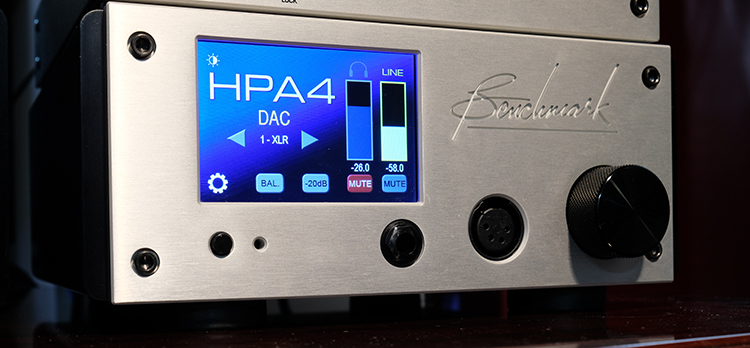
The HPA4, like all other Benchmark gear, is essentially half the width of traditional Hi-Fi gear making it equally at home sitting on a desktop or placed in an audio rack. The thick aluminum faceplate is dominated by the 3.5-inch (diagonal) touch screen. Through this simple interface I could: select inputs, adjust the balance, set independent level offsets per input (up to + or – 10 dB), mute the volume, dim the screen, adjust remote control settings and lock certain functions. There are also help screens that help explain various functions. The GUI (Graphic User Interface) is all rather intuitively worked out and is easy to navigate.
Secrets Sponsor
Below and to the left of the screen is a simple push-button for power on/off. To the right of that are the ¼-inch unbalanced headphone jack and the 4-pin XLR balanced headphone jack. The THX-888 based head amp section of the Benchmark HPA4 is said to have an Output Impedance of almost 0 Ohms, a Maximum Power output of 6-Watts into 16 Ohms, up to 1.5 Amps of output current, and up to 11.5 Vrms into a 300 Ohm load. All these specs when taken together mean that the HPA4 should have no problem driving very difficult or inefficient headphones and provide consistent and uncolored sound regardless of the headphone load. It is the same patented THX “Achromatic Audio Amplifier” technology that Benchmark uses, on an albeit larger scale, in their AHB2 power amplifier. The company provides an application note on the amplifier’s design and operation on its website.
And finally, there is that knurled black rotary volume knob. This is not a simple potentiometer that we are talking about here. Benchmark has implemented a fully balanced, relay-based gain control that uses 256 steps in 0.5 dB increments to ensure low-noise with consistent, precise level matching. According to the company “The HPA4 includes 4 independent 256-step attenuators: two for the L&R headphone outputs, and two for the L&R line outputs. To make this all happen, the HPA4 includes a total of 64 precision relays.” When used as a line-level preamp, the HPA4 is spec’d to have an SNR of more than 137 dB A-Weighted, with less than -125 dB of THD and up to 20 Vrms of output voltage.
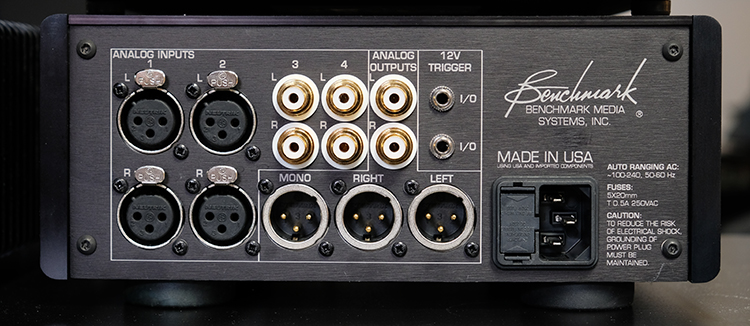
The smaller size of the HPA4 leaves very little free real estate on the backside. What space there is, is densely packed with pure analog inputs and outputs. There are two pairs of XLR inputs, 2 pairs of RCA inputs, one pair of RCA outputs, a pair of XLR outputs, and another single mono-summed XLR output which is suitable for a subwoofer I gather. Two 12-Volt trigger outputs and a grounded IEC socket for the power cable round out the rear panel inventory.
Benchmark provides a metal remote wand with rounded ends with the HPA4 which can control power, volume, muting, and input selection on both the HPA4 and a Benchmark DAC should you have one attached.

The AHB2 power amplifier looks for all the world like a shrunken Bryston 4B at first glance, with the minimalist silver faceplate and the black aluminum heat sinks on the sides. The front panel simply has the small black on/off button with a power LED next to it on the bottom left. To the right of that are two sets of three LEDs (one set per channel) indicating clipping, temperature warning, and muting.
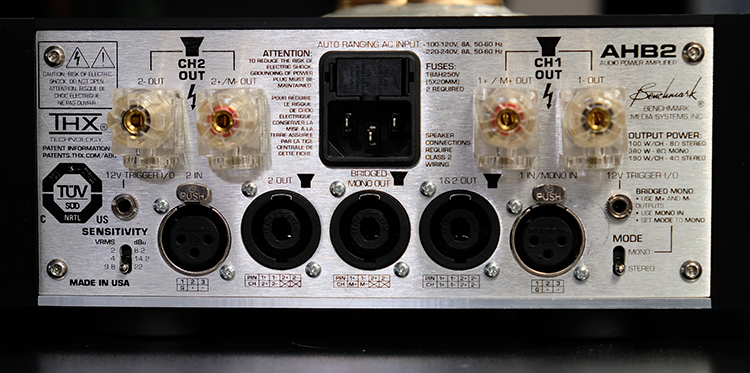
The rear panel is again densely populated with 2 pairs of speaker binding posts on the top half, on either side of the IEC power plug. Below these are a pair of XLR input jacks flanking a set of 3 Speakon speaker connectors, a pair for left and right, and a single one for when the amp is bridged into mono mode. Benchmark recommends using the Speakon connectors as they provide a better quality connection. 2 small toggle switches are on either side of the XLR connectors. One selects between three levels of amplifier gain (8.2 dBu, 14.2 dBu, and 22 dBu) while the other switches between stereo and bridged mono operation. There are also two 12 Volt trigger jacks to daisy-chain other components.
Again, the AHB2 is designed around the novel THX “Achromatic Audio Amplifier” technology which uses feed-forward error correction and is touted to have incredibly low levels of distortion with a wide dynamic range along with being able to drive difficult loads cleanly. What kind of power are we talking about? Well while 100-watts into 8 Ohms and 190-watts into 4 Ohms in stereo may not sound earth-shattering, consider that is with both channels driven, full bandwidth, and at a THD+N at less than 0.0003%! Most other amps list their power spec at anywhere from 0.1 to 1% THD+N and not always with both channels driven. It gets better. When bridged into mono, the AHB2 will put out 380-watts into 8-ohms at that same low distortion spec. Dynamic range is listed at an A-Weighted 132 dB in stereo and 135 dB in mono. And to top it off, the diminutive little amp is rated to drive 2-Ohm loads cleanly.


As I mentioned in the introduction Benchmark sent along a DAC3 B to round out this ensemble. Architecturally, it has the same ESS ES9028PRO based core converter as all of their current generation DACs, it just does away with any volume control, analog inputs, or headphone amp sections available in other models. Because of this fact it is labeled by the company as “the ideal converter to use in front of Benchmark’s HPA4 headphone amplifier or LA4 line amplifier.” The DAC3 B has essentially the same status LEDs on the front panel as in previous Benchmark DACs, denoting input selection, bitrate, and sampling frequency. The backside has both a single pair of balanced XLR and unbalanced RCA outputs. Five digital inputs are available: 2 coaxial, 2 optical, and 1 USB. One of the coaxial digital inputs can be reconfigured as a bit-perfect digital passthrough which adds to the unit’s flexibility. A new wrinkle with USB implementation is that the DAC no longer requires a dedicated driver if you are using a Windows 10 computer with the latest OS version. A 12 Volt trigger jack and IEC power connector round out the back-panel connections. Like all other Benchmark DACs, the DAC3 B has a selection of three different output levels on the balanced outputs. These can be changed via a set of jumpers inside the case. If using the XLR outputs, the company recommends setting the output level based on the sensitivity of the other components one has hooked up downstream of the DAC. The output choices work out to 1.27 Vrms (Attenuator = 20 dB), 3.89 Vrms (Attenuator = 10 dB), and 12.3 Vrms (Attenuator off). For most normal situations the 3.89 Vrms would be appropriate but with the full Benchmark stack in play, the default studio-level output of 12.3 Vrms would be the ideal choice ensuring the lowest noise and widest dynamic range throughout the signal chain.
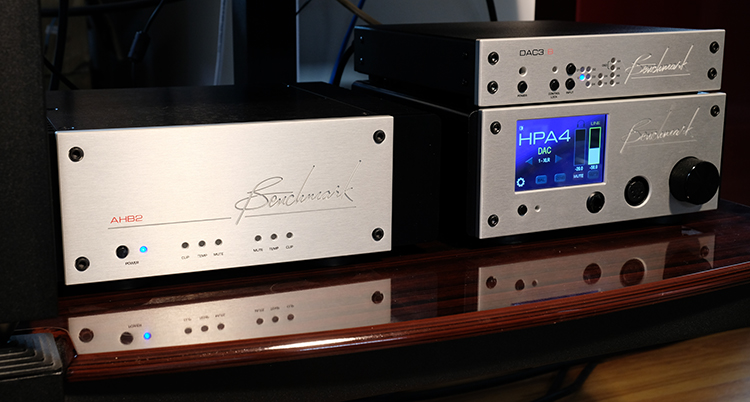
The Benchmark “stack” was used in my main studio 2-channel rig for a large portion of the review. In that implementation, it saw use with a wide variety of loudspeakers and other electronic equipment that Revel F228Be, the ELAC Uni-Fi 2.0, and the Sonus faber Olympica Nova 1 are just a small sampling of the speakers that have been in operation with this system along with a variety of DACs and phono preamps.
The HPA4, both with and without the DAC3 B, also saw duty as my primary headphone listening station, in tandem with my Surface 3 PRO tablet that uses ROON to oversee my digital music library. Again, it drove a wide variety of headphones that found their way into my studio and onto my noggin this past year.
Firstly, I want to acknowledge Benchmark Media’s indulgence with the time they afforded me on this little experiment. Wanting to experience the synergy of these three pieces meant I needed to sample them together and individually with other pieces of equipment to get a sense of any difference one way or the other. Having the Benchmark stack here for an extended period also made me re-evaluate a few things about how and what I use to review equipment but more on that aspect a little bit later.
The Benchmark Media HPA4 quickly showed itself useful in several headphone reviews that I had lined up. It had no issues driving the efficient Focal Stellia, Astell & Kern AK T5P II, and the slightly more demanding Monoprice Monolith M570 headphones cleanly. The HPA4 also did wonders for my Beyerdynamic DT 880 PRO which has a 250-Ohm impedance and needs a bit more “shove” to sound its best. There was also plenty of headroom to spare with that headphone so driving 600-Ohm cans should be a non-issue. In each use case, compared to the few portable headphone amps that I have around here and even the Focal Arche headphone amp that I reviewed, the HPA4 was just that much more transparent, giving me a more accurate sense of a given headphone’s true characteristics. As a straight-up preamplifier, the HPA4 has a noticeably lower noise floor and 2nd and 3rd order distortion products than my venerable old Bryston BP25 and even the Anthem STR preamplifier. Is this difference audible? I feel that it is although it is more subtle here. Swapping each of the preamps while connected to my Class D Audio SDS 470C or Anthem STR power amplifiers, I came away with the impression that the Anthem STR and Bryston BP25 sounded almost identical to each other while the HPA4 brought a touch more openness and clarity to the mix.
Turning to the Benchmark AHB2 power amplifier for a moment, it also brought similar transparency revelations when inserted into my existing system although from a different perspective. The three available gain settings (via a mini-toggle switch on the back panel) allowed me some flexibility when mating it with different preamplifiers. My Bryston BP25 worked just fine with the amp’s lowest gain setting (the same used with the HPA4) while the Anthem STR needed the highest setting. Swapping out my Class D Audio SDS 470C amplifier for the AHB2 quickly and rather starkly revealed how colored the SDS 470C actually sounded. I’ve known for a while that the SDS 470C had a warm and sweet character to its sound making it, and things connected to it, sound very agreeable but I don’t think I was quite expecting the dramatic difference that replacing it with the AHB2 would show. The sweetness and roundness to the sound were now completely gone. The result was not harshness or a flattening of the music, but more clarity. I could now hear more of the speakers and their true nature. More subtle nuances in vocals were the first details that I noticed. Then a tighter and more accurate pitch in electric and acoustic bass lines. The sound did not get leaner per se, it got more focused. That was the predominant takeaway. The difference was less dramatic when comparing the AHB2 to the Anthem STR power amp. I felt that the AHB2 still had a transparency advantage over the STR amplifier but it was more subtle. If anything, swapping to the AHB2 now reaffirmed my earlier observations on the limitations and characteristics of the other preamps. It also should be said that I suspect that the power ratings on the Benchmark AHB2 are conservative. While I didn’t have any truly demanding speakers to drive, my Bamberg Series 2 MTM Monitors are moderately demanding 4-Ohm speakers along with my original Salk SongTowers and I was able to drive both to fairly silly levels without a hint of strain or indication of amplifier clipping.
There is a bit less to say about the Benchmark DAC3 B beyond the fact that it is a finely executed example of a modern ESS-based digital to analog converter. It’s specifically designed to be used with Benchmark’s HPA4 or LN4 preamps since it has no other type of volume control and the DAC’s output levels (set via internal jumpers) can be used at the maximum settings when paired with either of those units. The full 12.3 Vrms output (XLR jacks) instead of the consumer standard 4 Vrms is said to allow higher SNR capability through the audio chain. I find that it’s hard to tell meaningful differences between well designed DACs when listening through speakers unless you are dealing with DACs having aggressively tuned or tube-based analog stages. I usually have to use headphones to help me lock in on differences in sound quality, and from what I could discern from using the HPA4 as the headphone amp and switching between pairs of DACs, level matched at the XLR inputs, the Benchmark DAC3 B’s sound is as clear and neutral as they come. If there is any issue that could be levied on the DAC is that its basic design is 4 years old and that tends to be a small lifetime in DAC product cycles these days. Most competing DACs can natively accept higher DSD and PCM sampling rates through their USB inputs so that may lessen the DAC3 B’s appeal to some audiophiles. That being said, the DAC3 B still holds up sonically to my ears, and in the end that is all that matters.
It should come as no surprise that, when the Benchmark DAC3 B, HPA4 preamplifier, and AHB2 power amplifier were used together they performed especially well. I dare say that they produced as clean and noise-free a stereo playback chain as I have ever come across. I found this type of transparency and neutrality very appealing but I realize that others may not necessarily agree because it is thoroughly revealing of any less-than-stellar source material. I have heard speakers and equipment in the past that I considered ruthless in their ability to reveal recording flaws but there really is no wiggle room with this Benchmark stack. Case in point, listening to vinyl through the HPA4 was not always an enjoyable experience as it laid bare the medium’s dynamic range and noise limitations more often than not. It made me wish that I had a tube-based phono preamp around to see if that would bring some of the warmness back that I like hearing in LPs. The Bryston and Anthem gear were noticeably more forgiving in that regard. The fact that the Benchmark gear delivered this level of performance while being able to fit all three components comfortably on a single shelf in my audio rack was almost more astonishing in and of itself!

Marchfourth Marching Band, Rise Up, CD Baby, FLAC 16/44.1, 2009.
I first heard the Marchfourth Marching Band’s track “Gospel” during the end credits of the Disney/Pixar movie Monster’s University. This isn’t just your standard college or university marching band fare (and granted, there are some talented school bands out there) but this is elevated stuff with infectious grooves and higher magnitude playing skill and finesse, along with being a visual performance group to boot. The aforementioned “Gospel” is a good place to start.
Listening to this track through the Focal Stellia Headphones plugged into the Benchmark HPA4 (with the FLAC files decoded by the DAC3 B) revealed tons of detail in the performer’s breathing as they blew into the various brass and woodwinds. There was also such a level of clarity that the pitch of each of the instruments was something I was able to notice more. The voices of the background singers had great presence and tone and the various layered drums and percussion had the right punch and feel to each of their sounds. The Benchmark preamp/headphone amp and DAC literally just got out of the way and let the headphones show what they were truly capable of.

Melody Gardot, Sunset In The Blue, Decca, 24/96 streamed via Qobuz, 2020.
I listened to Melody Gardot’s latest album with the full Benchmark “stack” playing through the Revel F328Be (review forthcoming) and it was an incredibly satisfying experience. The AHB2 power amp had no trouble keeping a tight grip on the big new Revels, the basslines sounding tight and punchy throughout the album. Listening to “There Where He Lives in Me” with both the full Benchmark stack and then swapping in my SDS 470C amplifier really showed how warm and slightly saccharine my Class D Audio amp made this song.
The SDS 470C was very smooth and enjoyable with this lush sounding almost Bossa-Nova material but I felt like it buffed over the edges of the notes a good bit. The AHB2 was comparatively like clear glass, Ms. Gardot’s vocals were clearer and more pinpoint while still retaining the smoothness of the performance. The ring and decay of the piano notes were noticeably cleaner and more well defined. The Revel F328Be had a lovely command of this music and I felt that the “stack” let them do their business with one less sonic fingerprint.

Joe Hisaishi/New Japan Philharmonic World Dream Orchestra, Symphonic Suite “Kiki’s Delivery Service”, Universal Music, 24/96 streamed via Qobuz, 2020.
Kiki’s Delivery Service is a favorite animated movie in this house along with being a part of my film study class in my college days. The musical score for this film is joyful and evocative of the young Kiki’s journey of discovery. This new recording of the film’s music is exquisitely done, clearly able to stand on its own as just pure music outside of the film. I used the Benchmark stack with the Revel F328Be, the ELAC Uni-Fi 2.0 UF5.2 towers, and the Sonus faber Lumina III towers (review forthcoming) while listening to this album.
The Revels projected the orchestra with an almost massive sense of scale and precise imaging of the instrument sections. The ELAC’s painted a deep, practically holographic image of performers in the recording space, while the Lumina III had a slightly leaner but very focused and satisfying presentation of the material. I experimented with the Anthem STR preamplifier with all these speakers in place of the Benchmark HPA4, and while using its onboard room correction in each case helped sort out the room issues concerning (below 300 Hz) bass reproduction, my ears kept telling me that I was losing something in the process. The additional sense of transparency the Benchmark components were providing was noticeable and I was missing it.

Wes Montgomery, In Paris: The Definitive ORTF Recording, 2xHD, 24/96 WAV Files, 1965.
Probably my favorite Wes Montgomery live recording. The engineers did a great job not only capturing the sound of Wes and his band, but they also captured a great sense of the concert space, the balance is very complimentary. The Benchmark stack’s transparent and revealing nature did a fantastic job of letting me enjoy the subtlest details of both the performers and the space they were in. During the opening of “Jingles,” both Montgomery and his piano player Harold Mabern play identical repeated phrases together to set the tone and pace of this instrumental.
With my trusty Bryston/Class D Audio setup, the tone and ring in the piano portion of these little duet parts got buried/smoothed over when listening on a few different speakers. In contrast, the Benchmark trio of components allowed me to hear the two distinct instruments completely during those same passages. The jazzy ring of the guitar strings and the ring of the piano notes were no longer blending together into one tone. Even the Anthem STR preamp and amp combo weren’t quite as revealing of these details. Better than the Bryston/Class D Audio combo but not as all-seeing as the Benchmark.
Measurements by Carlo Lo Raso, Technical Analysis by Carlo Lo Raso and David A. Rich
For THD, IMD, and frequency response tests I used my Lynx 2B professional soundcard teamed with SpectraPLUS measurement software. For square and sine wave analysis along with SNR measurements, I used the Quantasylum QA401 analyzer and its associated software. It should be noted upfront that because the HPA4s specifications exceed the limit of my test equipment, the results below are no doubt showing the limit of my Lynx Soundcard and my QA401 more than the HPA4’s true abilities. Still, we find the exercise instructive so we present the results.
For the HPA4 preamplifier, all measurements were performed at 2 Vrms and 4 Vrms unless otherwise indicated. Bench tests were done mainly on the HPA4. Editor-In-Chief John E. Johnson Jr, Ph.D. already did an extensive suite of bench tests on the DAC3 DX which is a very similar unit but with the addition of a headphone section and volume control. I did do a few other tests on the DAC3 B to compliment what John already has published. All my DAC tests have the unit’s output jumpers set to allow the full 12.3 V/24 dBu output through the XLR jacks. The SNR test was administered to the DAC3 B directly. All other DAC tests were routed through the HPA4, using its volume control to output 4 Vrms so as not to destroy my soundcard. I was not able to bench test the AHB2 amplifier as I am not set up to properly test power amps.
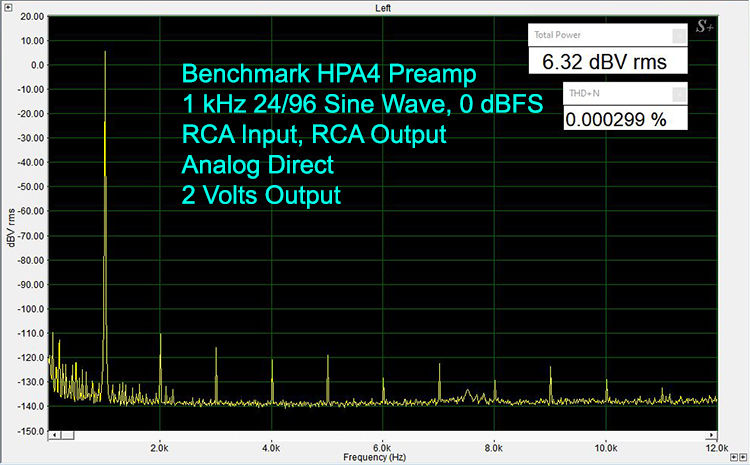
Starting on the HPA4 preamplifier, here is a 1 kHz 0 dBFS THD+N measurement taken through the RCA inputs and outputs at 2 Vrms. The resulting THD+N figure is 0.0003%. Any distortion products are at least 116 dB below the fundamental. Quite inaudible, even with the Lynx as the bottleneck.
It is highly likely that a preamp this expensive will be connected to a power amp via XLR connections. When this preamp is used with an RCA input and an XLR output, the gain acts in an unexpected way which is designed to maximize SNR. I quote from the designer John Siau:
“If you wish to use the HPA4 with a combination of RCA inputs and 4 Vrms consumer-grade XLR inputs, you should go into the volume setup menu on the HPA4 and set the “BOOST” on the XLR input to -10 dB. Once this is done, you can switch between 2 Vrms RCA inputs and 4 Vrms XLR inputs without experiencing a volume change. Try this by simultaneously connecting the XLR and RCA outputs of a single consumer-grade DAC. Once the BOOST is set to -10 dB on the XLR input, you will be able to switch between the XLR and RCA inputs without hearing a change in level. The relay gain control will automatically apply the required 10 dB offset. Remember, for a given playback level, this does not change the physical states of the relays, but it does change the displayed volume level so that a given displayed level will play equally loud on either the RCA or XLR inputs.”

Here is the same measurement, performed at 4 Vrms through the XLR inputs and outputs. THD+N is at 0.0002%. The third-order harmonic checks in at 117 dB below the fundamental, while the second-order harmonic is at 124 dB below. Any other spurs are lower still. Again this is all Lynx soundcard limitation.
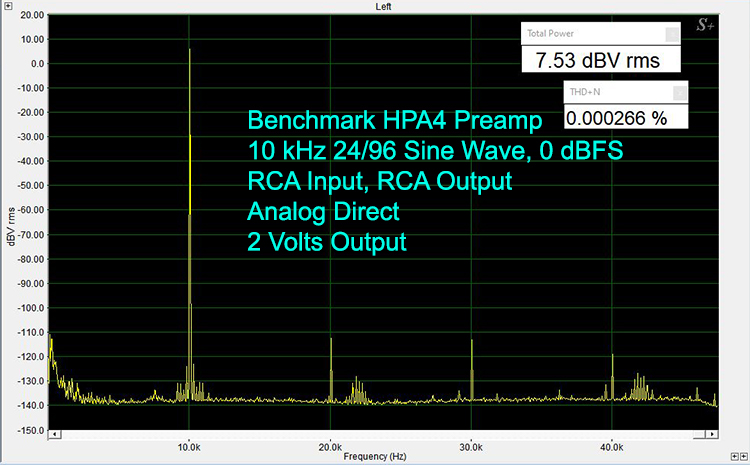
Here is the 10 kHz 0 dBFS THD+N measurement taken through the RCA inputs and outputs at 2 Vrms. The resulting THD+N figure is 0.0003%. Second and third-order harmonic distortion arrives at 119 dB below the fundamental. The RCA measurements in general are showing what may be power line noise at the low end of the spectrum which is not unusual with unbalanced connections. The levels that they appear at however are inaudible. This noise is absent in all the XLR measurements which is to be expected.

The same 10 kHz measurement performed at 4 Vrms through the XLR inputs and outputs show the THD+N still at roughly 0.0003%. All distortion products are at least 120 dB below the fundamental. Not to be heard. To see the limits of the HPA4 here, an AP analyzer with a notch filter is required.
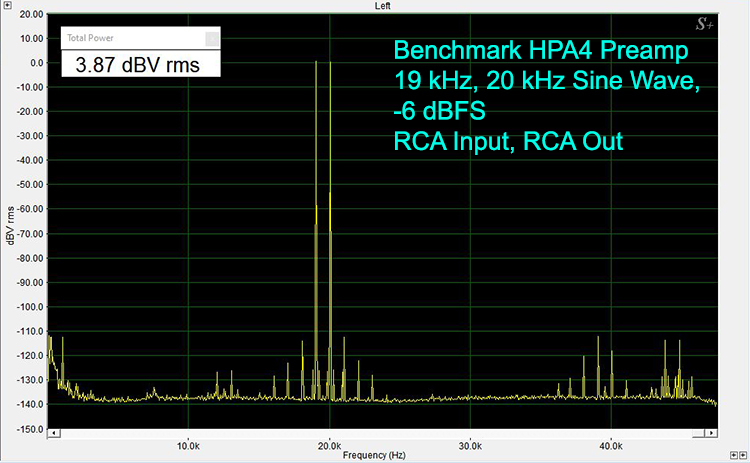
The 19 and 20 kHz test tones at -6 dBFS, though the RCA inputs and outputs produced some small sidebands and spurs, which fall below the level of audibility. The second-order harmonics at 38 and 40 kHz are at 124 dB and 120 dB below the fundamental.
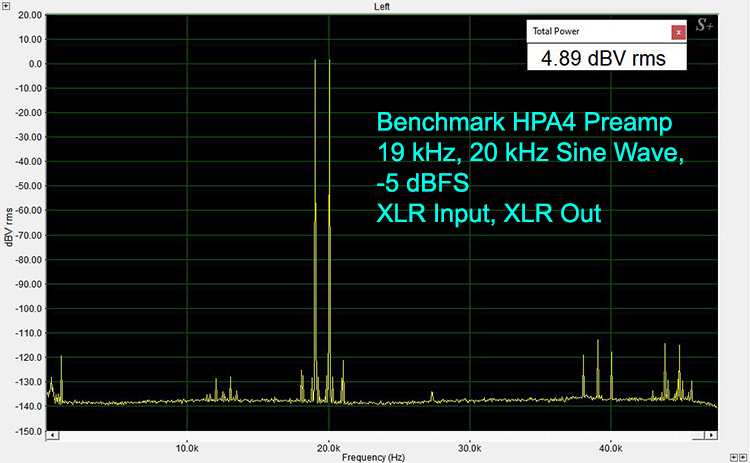
The same test repeated through the XLR inputs and outputs and using a -5 dBFS tone, results in a cleaner spectrum with even lower sidebands and spurs. The second-order harmonics at 38 and 40 kHz are at 123 dB and 122 dB below the fundamental.
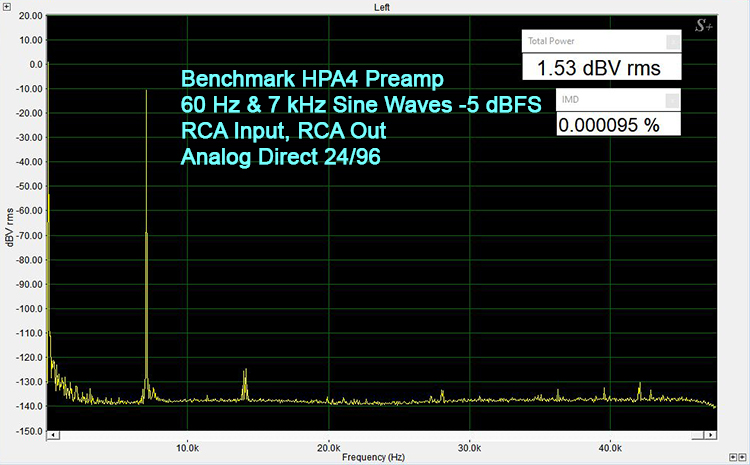
The 60 Hz and 7 kHz IMD test performed through the RCA jacks with a -5 dBFS tone produces an IMD figure of 0.0001%. Again, there is a slight rise in line noise at the low end of the spectrum, but you’ll never hear it.
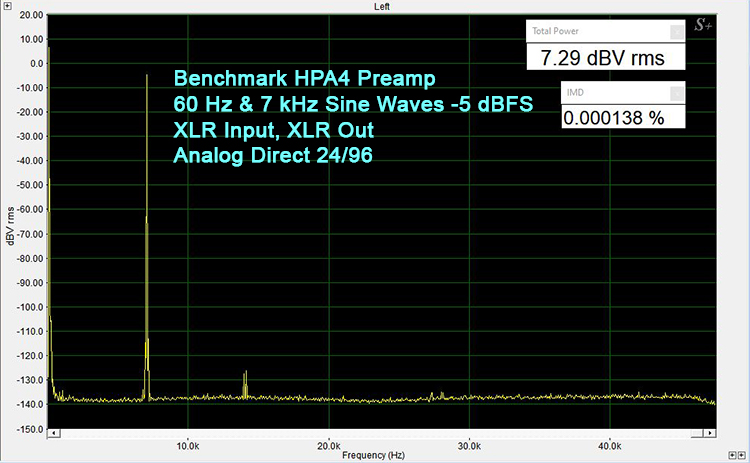
The same IMD test repeated through the XLR jacks produces essentially the same low IMD result of 0.0001%. This is accompanied by a complete lack of line noise and even less noise spur minutia. It bears repeating that these results are more reflective of the soundcards limits and not the preamp.
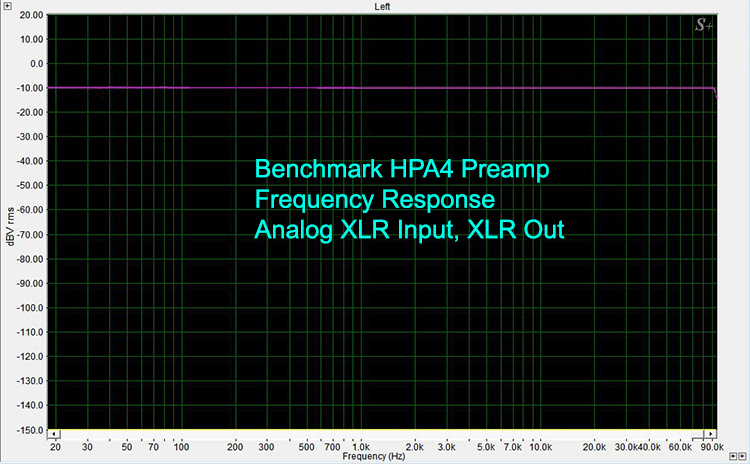
The frequency response measurement uses a 24/192 line sweep tone from 10 Hz to 96 kHz. The response is ruler flat out to just past 90kHz after which there is a sharp roll-off.
We tested the SNR of the Benchmark HP4 using the QuantAsylum QA 401 with the XLR inputs shorted. We reference the SNR to the typical consumer level of 4VRMS, not the professional level used by Benchmark. Until a level of -10dB on the preamp’s volume control, we were limited by the QA401 noise at 128dB. At a volume of -5dB, the SNR went down to 127dB again with some QA401 noise mixed in. With the HPA4 volume at 0dB, the SNR is out of the test instrument’s noise at 125dB. At +6dB volume, the noise is down to 124dB, and at +12dB volume level, the SNR is down to 121.5. The max gain is only +15dB yielding an SNR of 119dB.
David A Rich notes- All the SNR figures are state-of-the-art numbers. As are all the other performance aspects of the HPA4 shown in the user’s manual. This makes a nifty bench testing preamp so I suggested that Carlo keep it on the bench and use something else in his audio system. He was not amused.
The following tests are for the Benchmark DAC3 B:
Here we used the QuantAsylum QA401 again for SNR and time-domain measurements. Compared to the Lynx /Spectra Plus setup used elsewhere, the QA401 has the ability to measure SNR with a signal in place to prevent the DAC from muting so we can see any SNR change with level.
On the upside, QA401 allows for A-weighting. On the downside, the QA401 falls far behind the Lynx in distortion tests. This is the result of the ADC IC used in the QA401 versus the one used in the Lynx. One has lower distortion and the other lower noise. The QA401 sees a further distortion penalty as a result of the limited power available through its USB-only connection. The headroom for the electronics and available power for the opamps is thus compromised compared to the computer powered Lynx.

On the top of the graph, you can see the level relative to the full scale of 21.8dBV or 12.3VRMS. The QA401 in its low noise mode has a bug that shows dBr off by 20dB so what shows as almost -70dBr is actually -90dBr (blue box on top). The green box shows the signal level. We are -90dB down from 12.3VRMS which should produce a signal of 389mVRMS. In the green box, the signal is right on the money at 391mVRMS. The red box gives the SNR relative to the -90dBr signal. That is 35.1dB in the worst case channel. Adding back the 90dB to reference to full scale yields 125.1dB just on the Benchmark spec.
The low noise mode of the QA401 is limited to 2VRMS so you would not think I could connect the Benchmark DAC3 B to it with the internal 0dB jumpers selected, but for the SNR test, we use only small signals. Having the Benchmark produce 15dB more than the QA401 can take in is a good thing. The SNR of the QA401 is extended from its noise limit up to its maximum input level of 2VRMS up by 15dB. That turns out to be better than the Benchmark but not by much. If I included the residual noise of the QA401 in the SNR calculation it would be slightly higher at about 125.5dB.
Back to the graphs.
The above digital filter test, first suggested by Jurgen Reis of MBL Germany and used by John Atkinson of Stereophile, is designed to give us a look at the type and performance of the digital filter that a given DAC uses. Unique to John Atkinson’s presentation is applying the Reis white noise only in the right channel. In the left channel is a 19 kHz tone. This tone will produce reconstruction spurs if the digital filter is not sharp enough to attenuate them. The top half of the image shows the filter to be a textbook Fast Roll-Off Linear Phase type with excellent attenuation of the first reconstruction tone. The bottom half shows exactly the expected square wave that the filter should generate. The Benchmark DAC3 B has no other filter choices and you really don’t need them.
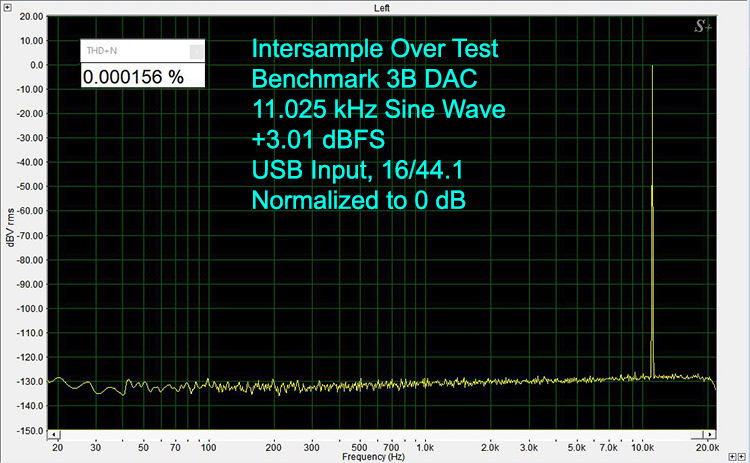
The Intersample Over Test was inspired by John Siau at Benchmark Media Systems. It consists of using an 11.025 kHz tone with +3.01 dB signal peaks occurring at a phase angle of 45-degrees from the sample clock. This puts the maximum waveform peaks (higher than 0 dB) between the digital samples. According to Siau, “If audio peaks always fell exactly on a sample, there would not be an intersample overload problem. Obviously, musical peaks rarely fall exactly on a sample and most often fall somewhere between samples. This means that most recordings will have peaks that are over 0 dBFS if the highest sample values are just reaching 0 dBFS.” This condition is more prevalent in 16-bit/44 kHz CD recordings and lower bitrate, lossy formats like MP3, and can produce DSP overload problems in DACs. The above image shows how the DAC3 B decodes the Intersample Over test tone, with no additional noise or spurious tones, showing only the pure 11 kHz tone. A Benchmark application note goes into much greater detail with figures.
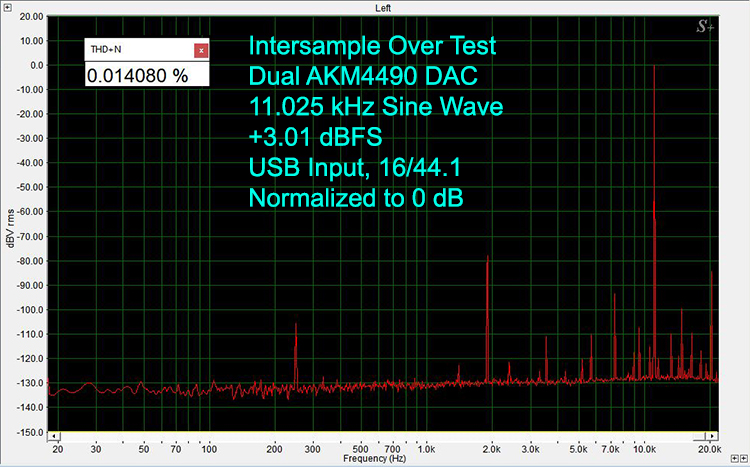
This is the same Intersample Over test repeated on a competitive $1500.00 DAC for comparison. Here the test produces a large number of spurious tones. The two largest ones at 78 dB (2 kHz) and 84 dB (22 kHz) below the fundamental, respectively. The distortions look to be non-harmonic and, in this case, the one at 2 kHz would be audible anytime an intersample peak exceeded 0 dB.
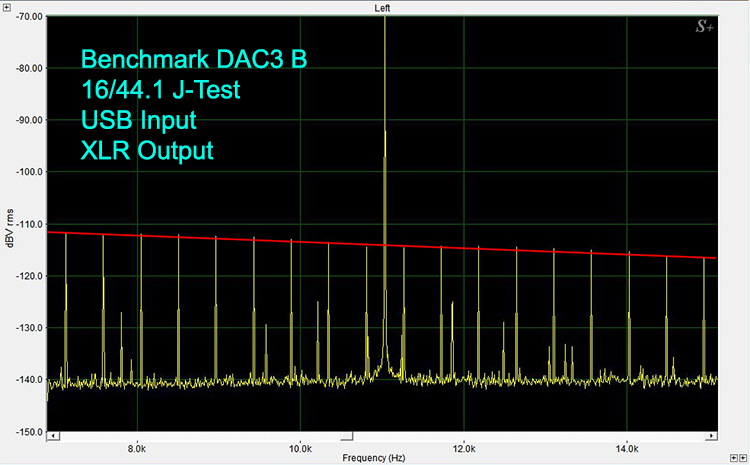
Here is the Julian Dunn J-Test for jitter at a sampling rate of 44.1k samples/sec.
The test is close to an 11 kHz tone at –3 dBFS down and is a small, low-frequency square wave that creates activity in the PCM data which makes it harder for the clock recovery circuit to produce a clock without some phase noise. I used a 16-bit test generated by REW introducing the square wave at an amplitude of the smallest level possible for 16-bit data which is called the least significant bit. An excellent explanation of the J-Test and the spurs the test produces can be found here.
John Atkinson identifies the spur’s amplitude and frequency of the J-Test in absence of jitter. John then comes up with an innovative line to be placed on a spectrum of the analog output of a DAC box which is reproducing the J-Test. Any spur below the line is inherent in the test and not from the DAC box.
As can be seen, the jitter of the Benchmark DAC3 B is below the limits of the test. The small residual spurs between the lines are small enough that we cannot tell if it is Jitter from the DAC3 B or the ADC we use to translate the signal back to digital to produce the spectrum.
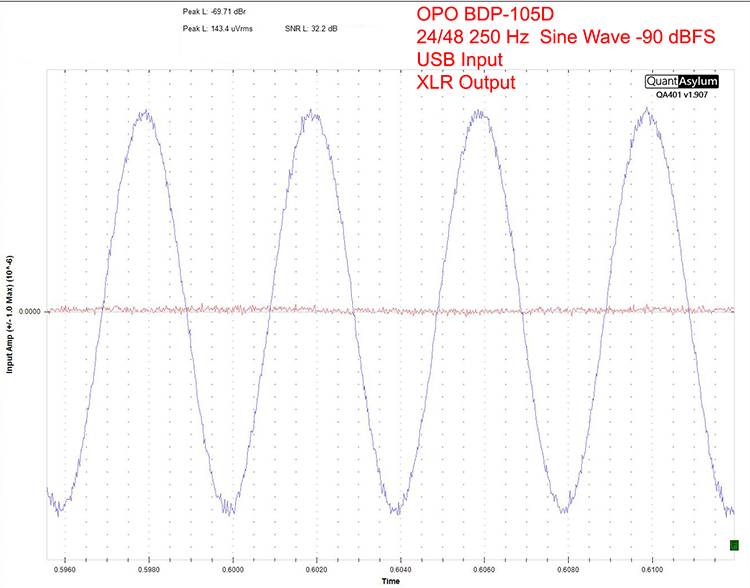
This is a time-domain plot of a -90 dBFS signal applied to the Oppo BDP-105D on the left channel. It is included here as a reference. The self-noise of the QA401 spectrum analyzer in time-domain mode is shown on the right channel which is grounded. The QA401 can be seen to have a suitably low noise level for something that isn’t an Audio Precision analyzer. Again the trick is here is in the range extension the Benchmark is providing me. The QA401 has a signal limit of 2VRMS but the Benchmark DAC3B is at 12.3VRMS. All the signals that will be presented in the following figures are far smaller than 2VRMS so the QA401 is safe with the Benchmark but the fact the output level is so much higher than 2VRMS range extends the QA401 by 15.8dB. With this trick the QA401 has the SNR of an AP but only because the Benchmark has such a high, ultra-low noise, output.
David A Rich notes- I point out that to do this trick using a DAC with a 2VRMS output one would need an ultra-low noise preamp to bring the gain up by 16dB. The Benchmark HPA4 would work out well for this sort of thing which is why it is better to keep it on the test bench than the equipment rack. Carlo keeps objecting and is now threatening to throw things at me.
As with the SNR measurement earlier, if you look at the top of the oscilloscope figure you will see the peak amplitude in dB (Peak L dBr) is off by -20dB, the amplitude in volts (Peak L uVrms), and the SNR relative to -90 dB. The QA401 only produces very low noise with a sampling rate of 48k samples/sec. To compensate, the sine wave used in the measurement is at 250Hz.
This OPPO provides us with an excellent result hence it’s used as a reference point. The BDP-105D has a signal to noise ratio of 124 dB with A-weighting. As with the SNR plot, what is displayed here is relative to the waveform’s amplitude of -90 dB so what is shown is 32 dB. The signal level is 143 uVRMS.

Here is the same plot for the Benchmark DAC3 B. The amplitude of the signal is over double that of the OPPO at 384.8 uVRMS. You can see how noticeably cleaner the Benchmark’s -90 dBFS sine wave is, given the better SNR from the range extension beyond the maximum signal level the QA401 can accept. The unweighted SNR of the DAC3 B at -90 dB is 32.7 dB. This is 2 dB lower than what we measured when we used A-weighting indicating a good design with respect to low-frequency noise and power supply hum.
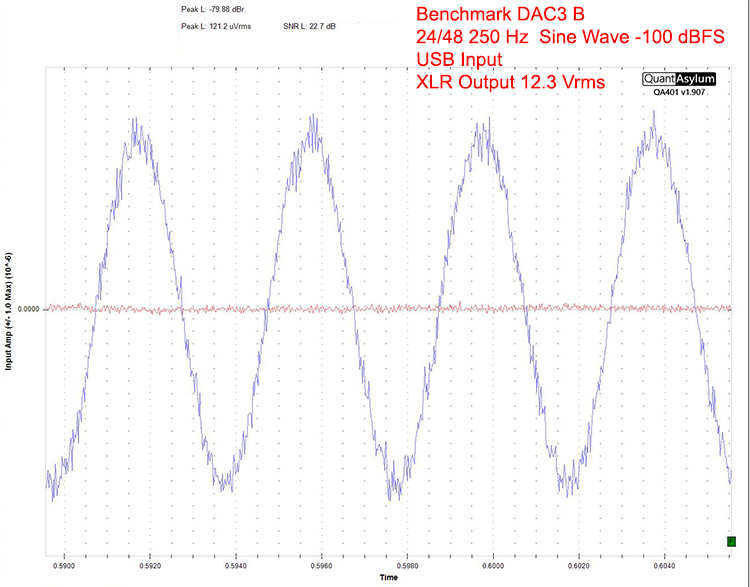
We’ve now dropped the level of the sine wave to -100 dBFS or 0.31 the size at -90 dBFS. The sine wave has an amplitude of 121.2 uVRMS. The signal to noise drops by 10 dB to 22.7 dB relative to the -100dB tone. This confirms the noise is up by a factor of 3 relative to the tone.
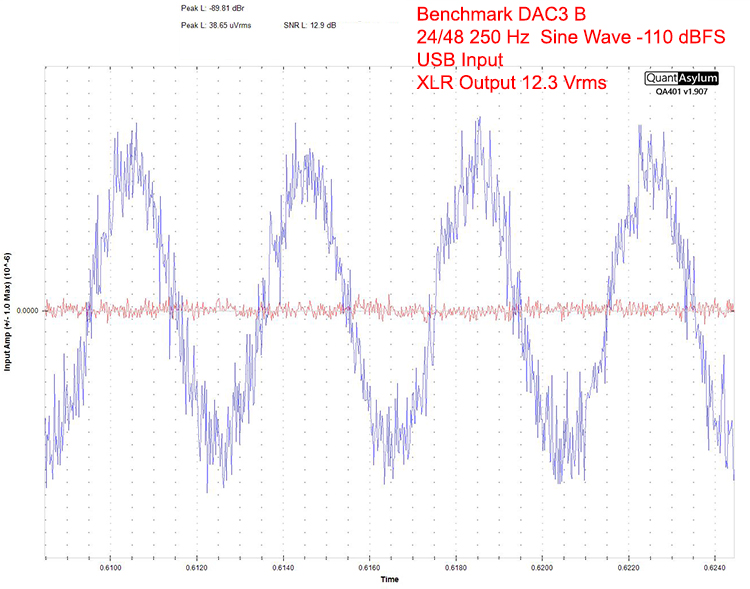
We take the digital input down another 10 dB to -110 dBFS which drops the level by another 0.31. Again the screen was magnified by 3 to make the wave look the same size as the two that preceded it. The noise of the Benchmark DAC3 B is making the sine wave harder to see but is still holding together well above its noise floor. The amplitude of the sine wave is at 38.65 uVRMS. The signal to noise ratio is now 12.9 dB relative to the -110 dBFS signal. Note if this was an MQA stream and not 24-bit linear PCM this sine wave would be noisier and be at the 17-bit SNR limit of MQA. We have far to go with 24-bit LPCM as we shall see.

We take the digital input down by another 10 dB to -120 dBFS. This is another reduction of 0.31 and the oscilloscope gain has been increased by 3. At -120 dB it is equivalent to 0.00001 of full scale. A million to one. The SNR is now 3.3 dB and yet the signal, while quite noisy, is still noticeably above the grounded self-noise of the QA401 and just holding together as a sine wave. This has everything to do with the DAC3 B’s excellent SNR performance and 12.3 Vrms full-scale output level. These sine wave results from -90 dB to -120 dB outperform both our reference OPPO player and the Audio-gd AS-1 DAC that we tested previously.
David A Rich notes- 20 years ago I would have thought this result would have been impossible. The thermal noise of the resistors in the analog components would exceed this small signal level but here it is in real life. Engineers are always pushing what appears to be impossible boundaries. Its Benchmark Media’s engineering on the DAC side and AKM engineering along with QuantAsylum on the ADC side. Intel helps at getting it all displayed on a PC with USB. I would also point out that I could make the OPPO results look a little better with the Benchmark HPA4 providing the extra gain but Carlo keeps telling me “hands off my reference preamp!”
Secrets Sponsor
The fact I want the Benchmark HPA4 on the test bench is because it is the only product that is not going to add noise and distortion to the DAC3 B. That is why Carlo wants it on his equipment rack. The same applies to the AHB2 power amp. Only these three blocks in series can produce a performance that one would think is at the limits of what is possible.
I fully expect Benchmark to push the limits further with the help of the designers of SOTA DAC chips.

The Benchmark HPA4 preamplifier, the AHB2 power amplifier, and the DAC3 B. I liked them so much that I purchased them for my reference system. Nuff said!
- The cleanest and most transparent sounding music chain that I’ve heard.
- All components have a small footprint.
- HPA4 is also a superb headphone amplifier.
- HPA4 touch-screen display is easy to use.
- AHB2 Power amplifier seems more powerful than its rating.
- DAC3 B is a textbook no-fuss, high-quality DAC.
- Alternate HPA4 display configuration with large volume level numbers visible at a distance.
- If the DAC3 B’s USB input could accept higher native PCM and DSD sampling rates.
The Benchmark Media Systems HPA4 preamplifier, AHB2 power amplifier, and DAC 3B are, individually, exceptionally transparent and well-designed audio devices. They are each top-shelf examples of their respective equipment categories in both measured and subjective performance. The fact that they are all as compact as they are is both a surprising and welcome bonus. When used as a system the resulting synergy was even more revealing. I found the system to be an extremely neutral reference point that allowed me to hear more of what a connected speaker or headphone was actually doing and, in turn, how much my existing electronics were adding to the sound that I was hearing in my reviews. I had thought that I already had equipment that afforded me a consistent and reliable reference point from which to judge and compare other gear. It wasn’t cream-of-the-crop high-end stuff but it was good quality and enjoyable equipment. Through the extended period that I had the Benchmark “stack”, I began to realize that I could do better. The HPA4, AHB2, and DAC 3B soon went from being review samples to becoming essential lab gear. I genuinely do enjoy listening to accurate, transparent (some may call it analytical) equipment. That however doesn’t mean I can’t like and appreciate the sound of good tube equipment, the sweetness of my vinyl collection, or even some very colored sounding solid-state equipment. But every reviewer needs a touchstone to work from and this equipment is now mine as I will be purchasing the review set. Is it perfection? No. But as the name says, it is my new benchmark.
The author wishes to thank David A. Rich for his valuable assistance in this review.


